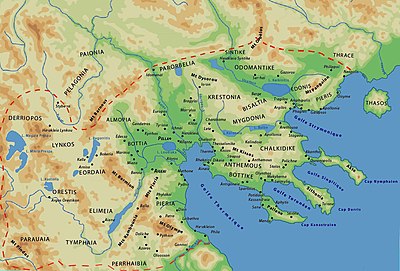Lynkestis
Lynkestis ( Greek Λυγκηστίς ), also called Lýnkos ( Λύγκος ), in ancient times referred to the southern section of a plateau, now called Bitola / Monastir plain, the geographical region of Upper Macedonia , located between Lake Prespa and Lake Vegoritida . Today it is located on both sides of the border between Greece ( Florina regional district in the West Macedonia region ) and North Macedonia (the south of the Pelagonia region ).
Adjacent to the Baba Mountains in the west , Lynkestis bordered there in antiquity on the Illyrian landscape of Dassaretia and in the northwest on Deuriopos . In the north-east the land extended roughly to the arch of the Erigon (Crna Reka) , which bordered Pelagonia . In the east the landscape reached to the mountain Barnous (Voras) , behind which the land sloped to the Lower Macedonian Almopia . In the southeast and southwest of Lake Vegoritida and Lake Kastoria, the also Upper Macedonian countries Eordaia and Orestis were adjacent.
In archaic times the Bitola / Monastir plain was settled by the pelagons, which is why the spatial term "pelagonia" was known as a synonym for the entire plain in the classical period. In an unspecified period of time, after a south-north movement by Elimiotis and Orestis , Macedonians must have taken possession of the plain from the south and subjugated the pelagons living there or displaced them to the north, to the landscapes of Deuriopos and the former Pelagonia north of the Erigon . The area occupied by the Macedonians was henceforth known under the name Lynkestis, which, according to Thucydides, was the original home of the Macedonians alongside the Elimiotis, who then expanded eastward into the Netherlands on the Thermaic Gulf . Like the other Upper Macedonian countries, Lynkestis was initially not covered by the Argead kingship established there and retained an archaic tribal structure for a long time. It was ruled by a princely house that claimed descent from the Bakchiads from Corinth . The princes were in rivalry with the Macedonian royal family, although the granddaughter of Arrhabaios I , Eurydice , married into it. In the early 4th century BC, the Lynkestis was threatened by incursions from neighboring tribes of the Illyrians and was temporarily occupied by them. Perdiccas III may have already subjugated . in the run-up to his fateful Illyrian campaign in 359 BC The land of direct royal rule, but at the latest this took place under Philip II. Among other things, he had the city of Herakleia Lynkestis (near Bitola ) built. In the army of Alexander the Great , warriors from the Lynkestis and Orestis formed a battalion of the Pezhetairoi .
After the Roman conquest of Macedonia in 168 BC. The lynkestic name disappeared as a geographical term, as the entire Bitola / Monastir plain was now administratively set up again under the name Pelagonia as one of the four Macedonian regions that existed in 146 BC. In the province of Macedonia .
Personalities
The Princely House:
- Bromeros
- Prince Arrhabaios I (called 424/423 BC), "King of the Lynkestic Macedonians"
- a daughter, married to Sirras
- Eurydice , married to King Amyntas III.
- Prince Arrhabaios II (mentioned 400/390 BC)
- Menelaus of the Pelagons (called 363/360 BC)
- a daughter, married to Sirras
- Prince Arrhabaios I (called 424/423 BC), "King of the Lynkestic Macedonians"
The family of Aeropos , a general of Philip II, probably descended from the lynkest royal house.
Occasionally, Leonnatos , a companion and bodyguard of Alexander, is accepted as a member of the lynkest princely family, since he is mentioned in the Suda as a relative of Eurydice .
literature
- Fritz Geyer: Macedonia up to Philip II's accession to the throne , In: Historische Zeitschrift , Vol. 30 (1930), pp. 1–148.
- AB Bosworth: Philip II and Upper Macedonia , In: The Classical Quarterly , Vol. 21 (1971), pp. 93-105.
- Robert Malcolm Errington : History of Macedonia. From the beginning to the fall of the kingdom . Munich 1986, ISBN 3-406-31412-0 .
Remarks
- ↑ Other spellings “Lýnkon” ( Λύγκον ; Strabon 7, 7, 8) and “Lýnkou” ( Λύγκου ; Thukydides 4, 83, 2).
- ↑ a b Strabo 7, 7, 8.
- ^ Strabo 7, 7, 4.
- ↑ See Geyer, p. 38.
- ↑ Thucydides 2, 99, 2.
- ↑ Diodorus 17, 57, 2.
- ^ Titus Livius 45, 29, 9.
- ↑ Thucydides 4, 83, 1.
- ↑ Suda "Leonnatos" , referring to Arrian ( Tà metà Aléxandron fr. 12). Curtius Rufus (10, 7, 8) calls Leonnatos "stirpe regia genitos". See Waldemar Heckel : The Marshals of Alexander's Empire , (Routledge 1993), p. 80.
